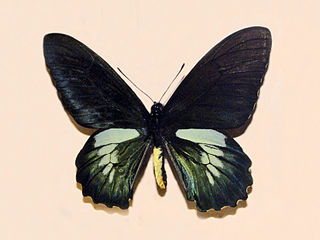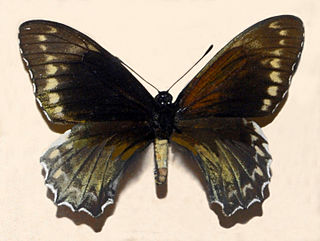
Delias eucharis, the common Jezebel, is a medium-sized pierid butterfly found in many areas of south and southeast Asia, especially in the non-arid regions of India, Bangladesh, Sri Lanka, Indonesia, Myanmar and Thailand. The common Jezebel is one of the most common of the approximately 225 described species in the genus Delias.

Elymnias hypermnestra, the common palmfly, is a species of satyrine butterfly found in South and Southeast Asia.

Papilio clytia, the common mime, is a swallowtail butterfly found in south and southeast Asia. The butterfly belongs to the subgenus Chilasa, the black-bodied swallowtails. It serves as an excellent example of a Batesian mimic among the Indian butterflies.

Battus polydamas, also known as the gold rim swallowtail, the Polydamas swallowtail or the tailless swallowtail, is a species of butterfly in the family Papilionidae. The species was first described by Carl Linnaeus in his 10th edition of Systema Naturae, published in 1758.

Morpho hercules, the Hercules morpho, is a Neotropical butterfly found in Brazil and Paraguay.

Papilio androgeus, the Androgeus swallowtail, queen page, or queen swallowtail, is a Neotropical butterfly of the family Papilionidae. It is found from Mexico to Argentina with a small population in southern Florida.

Papilio zagreus is a butterfly of the family Papilionidae (swallowtails). It is found in South America, including Venezuela, Colombia, Ecuador, Peru, Bolivia and western Brazil.

Battus laodamas, the green-patch swallowtail or yellow-spotted swallowtail, is a species of butterfly in the family Papilionidae.

Battus eracon, the west-Mexican swallowtail or Colima swallowtail, is a species of butterfly in the family Papilionidae. It is found in western Mexico where it is local and uncommon. The larvae feed on Aristolochia tentaculata.

Battus devilliersii is a species of butterfly from the family Papilionidae that is found in Cuba and the Bahamas.

Battus madyes, the Madyes swallowtail, is a species of butterfly from the family Papilionidae.

Battus belus, the Belus swallowtail is a species of butterfly from the family Papilionidae that is found in Brazil, Colombia, Guatemala, Peru and Venezuela.

Battus crassus, the Crassus swallowtail, is a species of butterfly from the family Papilionidae.

Colotis aurora, the sulphur orange tip or plain orange-tip, is a butterfly in the family Pieridae. It is found in Asia and Africa. The nominate subspecies, Colotis aurora aurora is found in India and Sri Lanka. The other subspecies, Colotis aurora evarne is found in Mauritania, Senegal, the Gambia, Mali, Burkina Faso, Ghana, Benin, Nigeria, Chad, Sudan, Ethiopia, Uganda, Kenya, Rwanda, Tanzania, the Democratic Republic of the Congo, Somalia, and southern Arabia.

Euphaedra eleus, the Eleus orange forester, is a butterfly in the family Nymphalidae. It is found in Guinea, Sierra Leone, Liberia, Ivory Coast, Ghana, Nigeria, Cameroon, Gabon, the Republic of the Congo, Angola, the Democratic Republic of the Congo and Uganda. The habitat consists of primary forests and secondary forests with a closed canopy.

Euphaedra perseis, the Perseis mimic forester, is a butterfly in the family Nymphalidae. It is found in Guinea (Conakry), Sierra Leone, Liberia, Ivory Coast and western Ghana. It was first described by Dru Drury in 1773.

Apantesis nais, the Nais tiger moth, is a moth of the family Erebidae. It was described by Dru Drury in 1773.

Parides phaleucas is a species of butterfly in the family Papilionidae. It was described by William Chapman Hewitson in 1869. It is found in Ecuador and Peru.

Mimoides protodamas is a species of butterfly in the family Papilionidae. The common name is false polysticto, with reference to the similarity of this species with Battus polystictus.




















